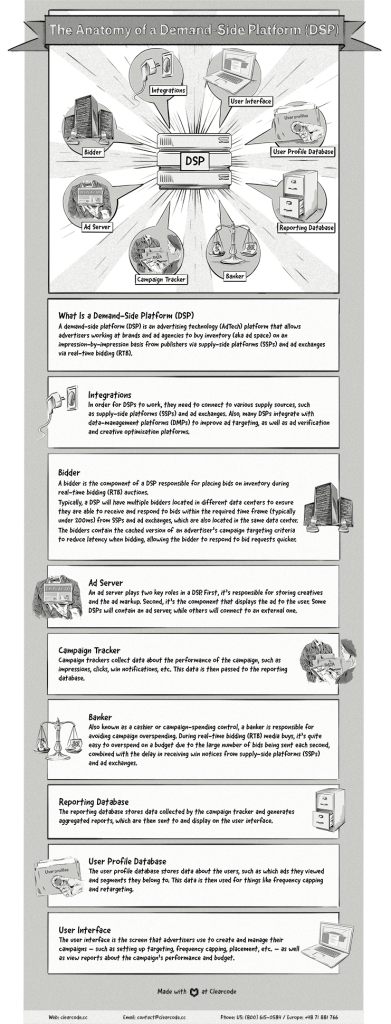Demand-side platforms (DSPs) are one of the main tools used by advertisers to run online media campaigns.
On the outside, they seem like a platform that’s used to simply buy ad space from publishers, but they are actually comprised of many different components that work behind the scenes, each playing a key role in the management, delivery and optimization of ad campaigns.
Let’s take a closer look at these various components with our Anatomy of a Demand-Side Platform (DSP) infographic:
Click here to open the DSP infographic in a new tab

Click here to open the DSP infographic in a new tab
What is a demand-side platform (DSP)
A demand-side platform (DSP) is an advertising technology (AdTech) platform that allows advertisers working at brands and ad agencies to buy inventory (aka ad space) on an impression-by-impression basis from publishers via supply-side platforms (SSPs) and ad exchanges via real-time bidding (RTB).
Integrations
In order for DSPs to work, they need to connect to various supply sources, such as supply-side platforms (SSPs) and ad exchanges. Also, many DSPs integrate with data-management platforms (DMPs) to improve ad targeting, as well as ad verification and creative optimization platforms.
We Can Help You Build a Demand-Side Platform (DSP)
Our AdTech development teams can work with you to design, build, and maintain a custom-built demand-side platform (DSP) for any programmatic advertising channel.
Bidder
A bidder is the component of a DSP responsible for placing bids on inventory during real-time bidding (RTB) auctions.
Typically, a DSP will have multiple bidders located in different data centers to ensure they are able to receive and respond to bids within the required time frame (typically under 200ms) from SSPs and ad exchanges, which are also located in the same data center.
The bidders contain the cached version of an advertiser’s campaign targeting criteria to reduce latency when bidding, allowing the bidder to respond to bid requests quicker.
Ad Server
An ad server plays two key roles in a DSP. First, it’s responsible for storing creatives and the ad markup. Second, it’s the component that displays the ad to the user. Some DSPs will contain an ad server, while others will connect to an external one.
Campaign Tracker
Campaign trackers collect data about the performance of the campaign, such as impressions, clicks, win notifications, etc. This data is then passed to the reporting database.
Banker
Also known as a cashier or campaign-spending control, a banker is responsible for avoiding campaign overspending. During real-time bidding (RTB) media buys, it’s quite easy to overspend on a budget due to the large number of bids being sent each second, combined with the delay in receiving win notices from supply-side platforms (SSPs) and ad exchanges.
Reporting Database
The reporting database stores data collected by the campaign tracker and generates aggregated reports, which are then sent to and display on the user interface.
User Profile Database
The user profile database stores data about the users, such as which ads they viewed and segments they belong to. This data is then used for things like frequency capping and retargeting.
User Interface
The user interface is the screen that advertisers use to create and manage their campaigns – such as setting up targeting, frequency capping, placement, etc. – as well as view reports about the campaign’s performance and budget.
We Can Help You Build a Demand-Side Platform (DSP)
Our AdTech development teams can work with you to design, build, and maintain a custom-built demand-side platform (DSP) for any programmatic advertising channel.








